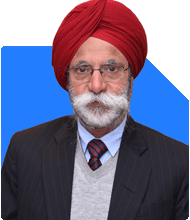Ramalingam Kalirajan |8317 Answers |Ask -Follow
Mutual Funds, Financial Planning Expert - Answered on Jul 13, 2024
He has an MBA in finance from the University of Madras and is a certified financial planner.
He is the director and chief financial planner at Holistic Investment, a Chennai-based firm that offers financial planning and wealth management advice.... more

Hello am 40, with monthly salary income of around 1.5 L, wife works part time with around 8k pm these are the only source of family income with 2 school going kids and my elderly dad. We own a house with 27k emi to be closed in next 6 to 7 years + equity corpus around 10L and wife has around 70k + my pf around 9L with some gold of around 200 gms + a small car in seconds + a 15 yr old Jevan Anand policy and company provided medicals+ around 1L in bank. Equity corpus was accumulated over a period of 2 years with invested amount of 6.6 L which is hovering around 10L current value and i am building these assets ongoing basis with around 20 k (10k+10k) pm investment on equity and gold family expenses around 40k pm. All these are self-made with not much guidance or external support. Wanted to understand if am on right track to support myself and my family needs for future. Also will it be wise to replace my small car with family car (around 10to 15L) with my financial situation now? I Dont wish to break any of my corpus considering any future or unforeseen events
Current Financial Situation
Income and Expenses
Your combined family income is Rs. 1.58 lakhs per month. With your wife's part-time income, this provides a good cushion. Monthly family expenses are Rs. 40k, and your home loan EMI is Rs. 27k. This leaves you with around Rs. 91k monthly for savings and investments.
Assets
Equity Corpus: Rs. 10 lakhs, accumulated over 2 years from an investment of Rs. 6.6 lakhs.
Gold: 200 grams.
Provident Fund: Rs. 9 lakhs.
Bank Balance: Rs. 1 lakh.
Insurance: Jeevan Anand policy for 15 years.
Car: A small second-hand car.
Liabilities
Your home loan has an EMI of Rs. 27k, which will be closed in 6-7 years. This is your primary liability.
Monthly Investments
Rs. 10k in equity.
Rs. 10k in gold.
Assessment of Current Investments
Equity Investments
Your equity investments have grown from Rs. 6.6 lakhs to Rs. 10 lakhs, showing a healthy appreciation. Investing Rs. 10k monthly in equity is a good strategy, considering the long-term growth potential.
Gold Investments
Investing Rs. 10k monthly in gold adds stability to your portfolio. Gold acts as a hedge against inflation and economic uncertainties.
Provident Fund
Your PF of Rs. 9 lakhs provides a safe and stable corpus for retirement. Continue contributing to this as it also provides tax benefits.
Jeevan Anand Policy
Jeevan Anand is a traditional endowment plan. While it offers life cover and returns, its growth rate is typically lower than other investment options. Consider reviewing this policy's performance and comparing it with other potential investments.
Financial Planning for the Future
Emergency Fund
Your current bank balance of Rs. 1 lakh is relatively low for an emergency fund. Ideally, you should have 6-12 months' worth of expenses in a liquid and accessible form. Considering your monthly expenses are Rs. 67k (including EMI), aim for an emergency fund of around Rs. 4-8 lakhs. This can be built gradually by setting aside a portion of your savings each month.
Child's Education
With two school-going kids, planning for their higher education is crucial. Education costs are rising, so starting early will give you a head start. You could allocate a portion of your monthly investments towards child education funds or children's mutual funds. These funds typically offer higher returns over the long term, helping you build a substantial corpus for their education.
Retirement Planning
You have a good start with your PF and equity investments. However, to ensure a comfortable retirement, consider diversifying your investments further. You might explore adding more equity funds, particularly diversified or actively managed funds, to your portfolio. These funds have the potential to offer higher returns compared to traditional investments.
Insurance Coverage
Your Jeevan Anand policy provides life cover, but it's essential to assess if it's adequate. With dependents, including two children and an elderly parent, ensure your life cover is sufficient to cover their needs in your absence. Consider term insurance for higher coverage at a lower premium.
Medical Insurance
While you have company-provided medical insurance, it's advisable to have a separate family floater plan. This ensures coverage continues even if you change jobs or retire. Evaluate the sum assured to ensure it covers major medical emergencies.
Decision on Upgrading the Car
Financial Impact
Replacing your small car with a family car worth Rs. 10-15 lakhs is a significant decision. If you finance the new car, it will add to your monthly EMIs. Consider the impact on your cash flow and whether it would strain your current financial commitments.
Current Financial Priorities
Your primary financial priorities should be building an emergency fund, securing your children's education, and planning for retirement. Upgrading your car, while providing comfort, should not compromise these goals. If you decide to go ahead, consider saving for a larger down payment to reduce the loan burden.
Alternatives
If your current car meets your family's needs, consider postponing the upgrade until you achieve more financial milestones. Alternatively, a certified pre-owned car can offer a balance between cost and comfort.
You've done an excellent job of managing your finances independently. Your dedication to investing regularly and building assets is commendable. Balancing a family's needs with long-term financial planning is challenging, and you've shown great foresight and discipline.
Managing finances with multiple dependents, including children and an elderly parent, can be stressful. It's understandable to seek reassurance and guidance. Your desire to secure your family's future reflects your responsibility and care.
Final Insights
You've made significant progress in building a stable financial foundation. Your focus on regular investments and prudent asset allocation is noteworthy. Moving forward, prioritize building a robust emergency fund, securing higher education for your children, and ensuring sufficient insurance coverage.
Evaluate your Jeevan Anand policy to ensure it aligns with your financial goals. Consider diversifying your investments with actively managed equity funds for better returns. Regarding upgrading your car, weigh the financial impact carefully and prioritize your primary financial goals.
If you need further personalized advice, consulting with a Certified Financial Planner can help refine your strategy and provide peace of mind.
Best Regards,
K. Ramalingam, MBA, CFP,
Chief Financial Planner,
www.holisticinvestment.in
You may like to see similar questions and answers below
Ramalingam Kalirajan |8317 Answers |Ask -Follow
Mutual Funds, Financial Planning Expert - Answered on Aug 03, 2024
Ramalingam Kalirajan |8317 Answers |Ask -Follow
Mutual Funds, Financial Planning Expert - Answered on Nov 07, 2024
Ramalingam Kalirajan |8317 Answers |Ask -Follow
Mutual Funds, Financial Planning Expert - Answered on Nov 06, 2024
Ramalingam Kalirajan |8317 Answers |Ask -Follow
Mutual Funds, Financial Planning Expert - Answered on Jan 02, 2025
Nayagam P P |4477 Answers |Ask -Follow
Career Counsellor - Answered on May 04, 2025
Nayagam P P |4477 Answers |Ask -Follow
Career Counsellor - Answered on May 04, 2025
Nayagam P P |4477 Answers |Ask -Follow
Career Counsellor - Answered on May 04, 2025
Dr Dipankar Dutta |1195 Answers |Ask -Follow
Tech Careers and Skill Development Expert - Answered on May 03, 2025
Dr Dipankar Dutta |1195 Answers |Ask -Follow
Tech Careers and Skill Development Expert - Answered on May 03, 2025
Radheshyam Zanwar |1591 Answers |Ask -Follow
MHT-CET, IIT-JEE, NEET-UG Expert - Answered on May 03, 2025
Dr Nagarajan Jsk |361 Answers |Ask -Follow
NEET, Medical, Pharmacy Careers - Answered on May 03, 2025
T S Khurana |461 Answers |Ask -Follow
Tax Expert - Answered on May 03, 2025
Kanchan Rai |583 Answers |Ask -Follow
Relationships Expert, Mind Coach - Answered on May 03, 2025
Kanchan Rai |583 Answers |Ask -Follow
Relationships Expert, Mind Coach - Answered on May 03, 2025

























